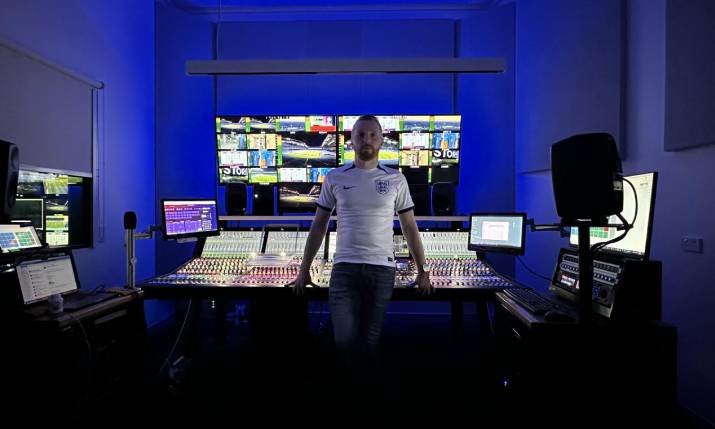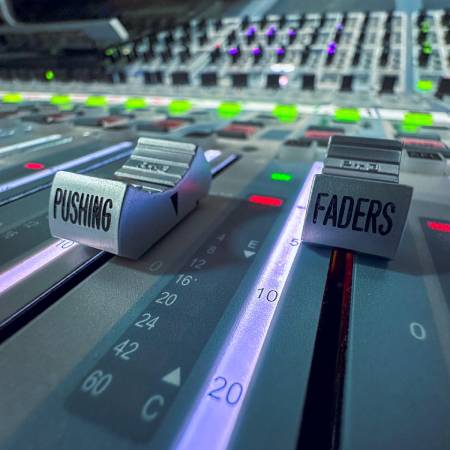Telling stories: How podcast Pushing Faders is giving a voice to the sports broadcasting audio community

Pushing Faders is a new podcast from Chris Eckford, which focuses on the broadcast audio community
2024 marks the 20th anniversary of when the podcast was first created, and today there is no limit to what you can listen to. With more than three million podcasts available to download, over 500 million listeners are getting their news, true crime and comedy fix direct from the cloud.
Punters are spoiled for choice, but you can count the number of podcasts dedicated to broadcast audio mixing on the fingers of two fingers.
Chris Eckford’s Pushing Faders, bought to listeners in association with SVG Europe Audio, is one of them. (The other is the Idle Hands podcast which top Canadian A1 Andrew Stoakley recorded during the pandemic, speaking to sound supervisors working across a range of sports in the US and Canada. Also, Eckford featured in the series’ only UK episode.)
Read more SVG Europe Audio joins forces with audio broadcast podcast Pushing Faders
Podcasts are the obvious medium for people who work in sound, but not for the reason you might think. An experienced sound supervisor who has been freelancing since 2019, Eckford spends a lot of his working life in a car, travelling to jobs and pulling into motorway service stations. These are the perfect time to catch up on podcasts, and he reckons the same is true of his fellow freelancers, and why when he is speaking to them for Pushing Faders he often asks what their favourite service station is.
“I’ve had feedback from listeners that say listening to the podcast is like having the people in in the car with you, but that’s where that question comes from!” says Eckford. “When you are working in outside broadcasting, you are always having to stop somewhere for a coffee because you’re in the middle of a four hour drive; it happens a lot!”
 All about teamwork
All about teamwork
Eckford is talking about the army of freelance engineers, sound supervisors, guarantees and A2s that he works with “in a car park” on broadcast jobs, and it was while working at the Women’s World Cup 2023 in Australia that he thought it would be good thing to give all these people a voice.
Because in the same way that football teams pull together in pursuit of a common goal – pun entirely intended – the same is true of the hundreds of people who come together to provide coverage for viewers at home. While each one might have a unique speciality, they are all striving to create the same thing. It’s totally a team effort.
“The original concept was to make it very job specific and to feature the range of people who contribute to the evolution of football coverage,” says Eckford. “It was only 30 years ago that football coverage was all mono, and it has quickly moved through stereo, 5.1 surround, and now immersive. I was keen to talk with all the people that have played a part in how sports audio coverage has developed.
“I have interviewed people like Ian Rosam and Robert Edwards about how they created the sound for the Premier League and the World Cup, but I have also spoken with people like Henry Goodman at Calrec, Nevile Hooper at NEP, and Mick Dwyer who was with Dolby for many years. All these people come from quite different backgrounds, but their careers are all intertwined with each other and play important roles in this evolution.”
Learning on the job
Eckford knows all about this evolution. In addition to managing the sound at the Women’s World Cup, he has covered the World Cup, the Euros, and Premiership football for Sky, as well as a host of other sports. But his idea to give a voice to people in that wider football audio ecosystem quickly developed into something else, tied into his own experience of learning on the job.
“The first time I mixed football for Sky I took photographs of the desk settings because I’d never formally learned how to mix football. But talking to Ian Rosam about why the attack time for the compressors on the ball kicks is 45 milliseconds was a Eureka moment; I knew that Sky did it that way because it was a set range on the desk, but I never thought about why it was like that and that somebody had figured out that the length of a ball kick is 45 milliseconds”
Growing up in Barnsley in South Yorkshire, Eckford first got into audio with a BTEC in Music Technology and within a few years was developing his skills in the most Yorkshire of ways.
“I started a company recording brass bands and choirs; there are a lot of them in Yorkshire,” he laughs, “but in 2010 a family friend told me about a trainee sound engineer position at Televideo in Sheffield. Within a year I was mixing simple football and four-camera rugby jobs, and I was made head of sound within about three years.
“Some of the best sound assistants I know have come out of Televideo because we were working on jobs where we might’ve been the only sound assist, but there were five positions to rig; you become good at finding your way around. I was mixing and guaranteeing at the same time, and being thrown at the deep end means you became very resilient.”

Chris Eckford [right] with freelance OB sound supervisor and guarantee engineer, Bob Stephens in Qatar at the Men’s World Cup 2022
The lack of formal training courses for broadcast audio is not uncommon. Consequently, most of Eckford’s training was on the job. It taught him that different sports require different setups, workflows and requirements, and the lack of training meant that the most common way to get started was to inherit what has gone before.
It is something that still affects the industry today, and one of the outcomes of the Pushing Faders series has been to demystify some of the approaches which sound supervisors apply when approaching a particular sport.
“Pushing Faders started as one concept, but then it developed when I realised that it can’t be that specific,” explains Eckford. “Most of the sound supervisors I’ve spoken to have learned on the job in a similar way as I did, but they have tweaked what they’ve learned to improve the output. We’ve all developed our roles by learning something new, or making a mistake, or being forced into a change which turns out to be beneficial.
“The first time I mixed football for Sky I took photographs of the desk settings because I’d never formally learned how to mix football. But talking to Ian Rosam about why the attack time for the compressors on the ball kicks is 45 milliseconds was a Eureka moment; I knew that Sky did it that way because it was a set range on the desk, but I never thought about why it was like that and that somebody had figured out that the length of a ball kick is 45 milliseconds.
“At first I did wonder if people would want to talk about how they work or whether it would feel like they were giving away the keys to their kingdom, but every person I’ve asked to come on the podcast has been dead up for it.”
Whims of the event
Another benefit has been finding out how people have had to adjust the way they work, because even in sports where settings are standardised or copied from a previous desk memory, there are always adjustments to make and new things to learn.
Eckford says: “In sports, you are always at the control and the whims of the event. At the World Cup we have a predetermined microphone diagram, with secondary positions if it doesn’t work at a particular venue, but there were still a couple of grounds which didn’t work for any of the designated positions. Even when you have a clear idea as to what you want to do, you still have to make it work when it doesn’t.
“In the podcast with Lynn Munro about how she mixes Wimbledon, she was explaining that she couldn’t get exactly want she wanted because of advertising and the fact that the Rycote windshields having to be a specific shade of green to fit in. It’s similar to football where your mics around the pitch can be affected if they’re in the wrong place and blocking the advertising boards.”
Future plans
As well as pursuing its original agenda to spotlight the individuals who contribute to the end result, Eckford is keen to open the door to learn how more people are mixing certain sports: “I’d like to talk to the people who mixed the live Squid Games, mainly because it had around 400 radio mic channels recording to time code and I would love to know how that was all managed. I’m trying to get the person who mixes the UFC, as well as the person who mixes the Super Bowl because I’m such a big fan of the NFL!
“I don’t know how many non-sound have listened to it, but I would love to get some feedback from any that do to find out what they’ve taken from it and what they think we do. A few weeks ago I was talking to a camera operator I’ve known for quite a few years, and he had listened to the podcast and said it now “makes sense why you do all this stuff that you do”! It gives non-audio people in the production chain more empathy and understanding about what sound is about.
“And it’s also been good to learn about people’s careers rather than just talking to them in passing in a car park.”
Pushing Faders is now bought to listeners in association with SVG Europe Audio. Eckford commented on the association with SVG Europe: “I’m very happy to have SVG Europe onboard with Pushing Faders. Having the backing of such a great industry resource shows that people are interested in what the guests of the podcast have to say, and hopefully it will become a great way of sharing information and knowledge throughout the industry.”
Pushing Faders is available on all the usual podcast platforms. Click here for more details. Listen to all the Pushing Faders episodes here.

